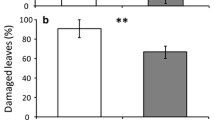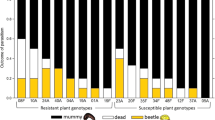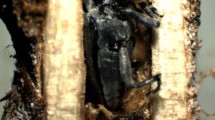Abstract
Plant breeding has improved traits such as fruit flavor and yield but may have compromised direct and indirect defenses to herbivores compared to their wild ancestors. This has been termed the plant domestication-reduced defense hypothesis. We present evidence that domestication of Capsicum annuum (the chili pepper) from its wild progenitor, Capsicum annuum var. glabriusculum, has not affected resistance to the insect herbivore, Manduca sexta (the tobacco hornworm). Caterpillars performed equally well on the domesticated and wild pepper. Subsequent behavioral choice assays with one of the main natural enemies of M. sexta, the parasitoid wasp Cotesia congregata, showed that parasitoids preferentially chose herbivore-damaged domesticated pepper plants over their wild relative. To investigate this tri-trophic interaction further, we then assessed the efficiency of C. congregata to parasitize M. sexta on numerous wild pepper accessions and domesticated pepper cultivars in a large foraging enclosure. We found that herbivores feeding on domesticated plants were parasitized at more than twice the rate of those on wild genotypes. These results imply that pepper domestication has not changed resistance to herbivorous insects (i.e., leaf palatability as a direct defense), but rather has improved volatile attraction to recruit natural enemies.




Similar content being viewed by others
References
Adler LS, Wink M, Distl M et al (2006) Leaf herbivory and nutrients increase nectar alkaloids. Ecol Lett 9:960–967
Ashmead W (1887) Report on insects injurious to garden crops in Florida. Bull Div Entomol US Dept Agric 14:9–29
Baldwin IT, Karb MJ (1995) Plasticity in allocation of nicotine to reproductive parts in Nicotiana attenuata. J Chem Ecol 21:897–909
Bredlau JP, Mohajer YJ, Cameron TM et al (2013) Characterization and generation of male courtship song in Cotesia congregata (Hymenoptera: Braconidae). PLoS ONE 8:e62051
Brooks ME, Kristensen K, van Benthem KJ, Magnusson A, Berg CW, Nielsen A, Skaug HJ, Maechler M, Bolker BM (2017) glmmTMB balances speed and flexibility among packages for zero-inflated generalized linear mixed modeling. R J 9:378–400
Bosland PW, Iglesias J (1992) NuMex Bailey Piquin’Chile Pepper. HortScience 27:941–942
Campan E, Benrey B (2004) Behavior and performance of a specialist and a generalist parasitoid of bruchids on wild and cultivated beans. Biol Control 30:220–228
Chen YH, Gols R, Benrey B (2015a) Crop domestication and its impact on naturally selected trophic interactions. Annu Rev Entomol 60:35–58
Chen YH, Gols R, Stratton CA et al (2015b) Complex tritrophic interactions in response to crop domestication: predictions from the wild. Entomol Exp Appl 157:40–59
Chen YH, Welter SC (2007) Crop domestication creates a refuge from parasitism for a native moth. J Appl Ecol 44:238–245
Clement CR, de Cristo-Araújo M, Coppens D’Eeckenbrugge G et al (2010) Origin and domestication of native Amazonian crops. Diversity 2:72–106
Degenhardt J, Hiltpold I, Köllner TG et al (2009) Restoring a maize root signal that attracts insect-killing nematodes to control a major pest. Proc Natl Acad Sci 106:13213–13218
Fatouros NE, Broekgaarden C, Bukovinsz’Kinekiss G et al (2008) Male-derived butterfly anti-aphrodisiac mediates induced indirect plant defense. Proc Natl Acad Sci 105:10033–10038
Fulton BB (1940) The hornworm parasite, Apanteles congregatus (Say) and the hyperparasite, Hypopteromalus tabacum (Fitch). Ann Entomol Soc Am 33:231–244
Gaillard MD, Glauser G, Robert CA et al (2017) Fine-tuning the ‘plant domestication-reduced defense’ hypothesis: specialist vs generalist herbivores. New Phytol 217:355–366
Garvey MA, Creighton JC, Kaplan I (2020) Tritrophic interactions reinforce a negative preference–performance relationship in the tobacco hornworm (Manduca sexta). Ecol Entomol 45:783–794
Gilmore JU (1938a) Notes on Apanteles congregatus (Say) as a parasite of tobacco hornworms. J Econ Entomol 31:712–715
Gilmore JU (1938b) Observations on the hornworms attacking tobacco in Tennessee and Kentucky. J Econ Entomol 31:706–712
Giraudoux P (2018) pgirmess: spatial analysis and data mining for field ecologists. R package version 1.6.9
Gols R, Van Dam NM, Raaijmakers CE et al (2009) Are population differences in plant quality reflected in the preference and performance of two endoparasitoid wasps? Oikos 118:733–742
Gols R, Bullock JM, Dicke M et al (2011) Smelling the wood from the trees: non-linear parasitoid responses to volatile attractants produced by wild and cultivated cabbage. J Chem Ecol 37:795–807
Haak DC, McGinnis LA, Levey DJ et al (2012) Why are not all chilies hot? A trade-off limits pungency. Proc R Soc London B 279:2012–2017
Harvey JA, Malcicka M, Ellers J (2015) Integrating more biological and ecological realism into studies of multitrophic interactions. Ecol Entomol 40:349–352
Hayano-Kanashiro C, Gámez-Meza N, Medina-Juárez LÁ (2016) Wild pepper Capsicum annuum L. var. glabriusculum: Taxonomy, plant morphology, distribution, genetic diversity, genome sequencing, and phytochemical compounds. Crop Sci 56:1–11
Kassambara A, Kosinski M, Biecek P et al (2017) Package ‘survminer’: drawing survival curves using ‘ggplot2’. R package version 0.3.1
Kessler A, Baldwin IT (2001) Defensive function of herbivore-induced plant volatile emissions in nature. Science 291:2141–2144
Köllner TG, Held M, Lenk C et al (2008) A maize (E)-β-caryophyllene synthase implicated in indirect defense responses against herbivores is not expressed in most American maize varieties. Plant Cell 20:482–494
Kraft KH, Brown CH, Nabhan GP et al (2014) Multiple lines of evidence for the origin of domesticated chili pepper, Capsicum annuum, in Mexico. Proc Natl Acad Sci 111:6165–6170
Lawson FR (1959) The natural enemies of the hornworms on tobacco (Lepidoptera: Sphingidae). Ann Entomol Soc Am 52:741–755
Length RV (2019) emmeans: estimated marginal means, aka least-squares means. R package version 1.3.2
Li X, Garvey M, Kaplan I et al (2018) Domestication of tomato has reduced the attraction of herbivore natural enemies to pest-damaged plants. Agric For Entomol 20:390–401
Luo XJ, Peng J, Li YJ (2011) Recent advances in the study on capsaicinoids and capsinoids. Eur J Pharmacol 650:1–7
Madden AH, Chamberlin FS (1945) Biology of the tobacco hornworm in the southern Cigar-Tobacco District. United States Dept Agric Tech Bull 896:1–51
Pickersgill B (2016) Chile peppers (Capsicum spp.). Ethnobotany of Mexico. Springer, New York, pp 417–437
Qin C, Yu C, Shen Y et al (2014) Whole-genome sequencing of cultivated and wild peppers provides insights into Capsicum domestication and specialization. Proc Natl Acad Sci 111:5135–5140
R Core Team (2017) R: a language and environment for statistical computing. R Foundation for Statistical Computing, Vienna
Rasmann S, Kollner TG, Degenhardt J et al (2005) Recruitment of entomopathogenic nematodes by insect-damaged maize roots. Nature 434:732–737
Reisenman CE, Riffell JA, Bernays EA et al (2010) Antagonistic effects of floral scent in an insect–plant interaction. Proc R Soc London B 277:2371–2379
Riffell JA, Alarcón R, Abrell L et al (2008) Behavioral consequences of innate preferences and olfactory learning in hawkmoth–flower interactions. Proc Natl Acad Sci 105:3404–3409
Rowen E, Kaplan I (2016) Eco-evolutionary factors drive induced plant volatiles: a meta-analysis. New Phytol 210:284–294
Stanton MA, Preβler J, Paetz C, Boland W, Svatoš A, Baldwin IT (2016) Plant-mediated pheromone emission by a hemipteran seed feeder increases the apparency of an unreliable but rewarding host. New Phytol 211:113–125
Tamiru A, Bruce TJ, Woodcock CM et al (2011) Maize landraces recruit egg and larval parasitoids in response to egg deposition by a herbivore. Ecol Lett 14:1075–1083
Tamiru A, Khan ZR, Bruce TJ (2015) New directions for improving crop resistance to insects by breeding for egg induced defence. Curr Opin Insect Sci 9:51–55
Tamiru A, Bruce TJ, Richter A et al (2017) A maize landrace that emits defense volatiles in response to herbivore eggs possesses a strongly inducible terpene synthase gene. Ecol Evol 7:2835–2845
Tewksbury JJ, Nabhan GP (2001) Seed dispersal: directed deterrence by capsaicin in chillies. Nature 412:403–404
Tewksbury JJ, Reagan KM, Machnicki NJ et al (2008) Evolutionary ecology of pungency in wild chilies. Proc Natl Acad Sci 105:11808–11811
Turcotte MM, Turley NE, Johnson MT (2014) The impact of domestication on resistance to two generalist herbivores across 29 independent domestication events. New Phytol 204:671–681
Whitehead SR, Poveda K (2011) Herbivore-induced changes in fruit–frugivore interactions. J Ecol 99:964–969
Whitehead SR, Bowers MD (2013) Evidence for the adaptive significance of secondary compounds in vertebrate-dispersed fruits. Am Nat 182:563–577
Whitehead SR, Jeffrey CS, Leonard MD et al (2013) Patterns of secondary metabolite allocation to fruits and seeds in Piper reticulatum. J Chem Ecol 39:1373–1384
Whitehead SR, Turcotte MM, Poveda K (2017) Domestication impacts on plant–herbivore interactions: a meta-analysis. Philo Trans R Soc London B 372:20160034
Yamamoto RT, Fraenkel GS (1960) The specificity of the tobacco hornworm, Protoparce sexta, to solanaceous plants. Ann Entomol Soc Am 53:503–507
Zimmer AR, Leonardi B, Miron D et al (2012) Antioxidant and anti-inflammatory properties of Capsicum baccatum: from traditional use to scientific approach. J Ethnopharmacol 139:228–233
Acknowledgements
This work was supported by an NSF Graduate Research Fellowship, award number DGE-1333468. The authors would like to thank Drs. Juli Carrillo, Kathryn Ingerslew, Laura Ingwell, Ulianova Vidal-Gomez, Peter Dunn, Michael Scharf, and Jason Hoverman for providing thoughtful comments to improve the experiments and manuscript; Wadih Ghanem and Dr. Ulianova Vidal Gómez for help conducting experiments; Dr. Robert Raguso for supplying tobacco hornworms; and Drs. Justin Bredlau and Karen Kester for suppling parasitoid wasps. Data for the associated described experiments are available from the authors upon request.
Author information
Authors and Affiliations
Contributions
MG, CC, and IK conceived the ideas and designed methodology; MG collected the data; MG analyzed the data; MG led the writing of the manuscript. All authors contributed critically to the drafts and gave final approval for publication.
Corresponding author
Ethics declarations
Conflict of interest
The authors declare no conflict of interest.
Additional information
Handling Editor: Jarmo Holopainen and Heikki Hokkanen.
Publisher's Note
Springer Nature remains neutral with regard to jurisdictional claims in published maps and institutional affiliations.
Rights and permissions
About this article
Cite this article
Garvey, M., Creighton, C. & Kaplan, I. Pepper domestication enhances parasitoid recruitment to herbivore-damaged plants. Arthropod-Plant Interactions 14, 695–703 (2020). https://doi.org/10.1007/s11829-020-09788-z
Received:
Accepted:
Published:
Issue Date:
DOI: https://doi.org/10.1007/s11829-020-09788-z




